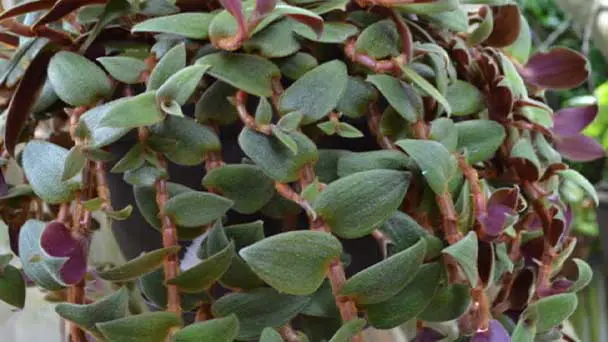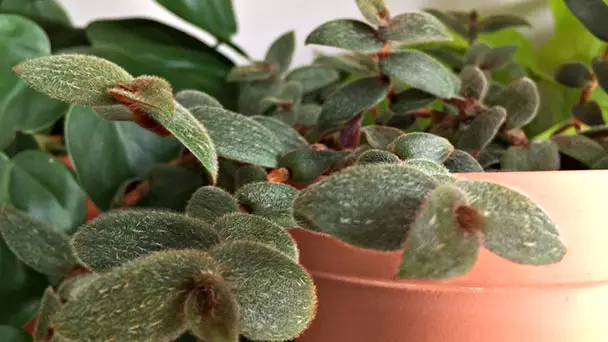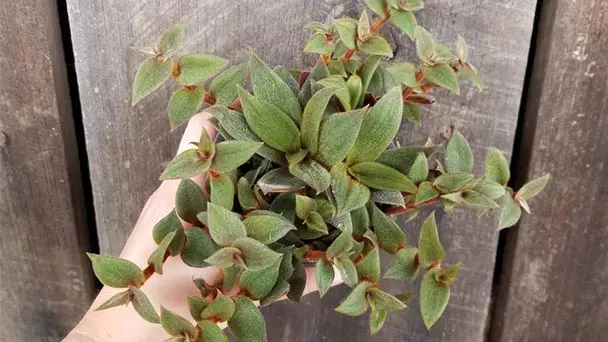How to Care for Teddy Bear Vine - Houseplant Growing
Written by Ivy
Nov 11 2021

Teddy bear vine is a succulent plant belonging to kale in the Crassulaceae family, because the leaves of teddy bear vine are round and short, and the serrated outer edge is just short. The serrated leaves look like small bear paws, which is also similar to the fat version of chocolate soldiers. Many people say that teddy bear vine was born with dwarfing agent, but it has not been confirmed yet.

If teddy bear vine does grow air roots, how do we start teddy bear vine pruning? First of all, we should trim some old leaves closest to the root. The simple way is to screw off the old leaves directly by hand, which can reduce the consumption of meat nutrition and easily make the trunk grow into old stumps. If the conservation is polycephalous, teddy bear vine pruning needs to be carried out on the lateral branches to reduce the nutrient consumption. Of course, the fleshy branches we trimmed can also be re cutted in the pot to grow new plants.
Solution: we should change the pots and soil for Teddy Bear vine as soon as possible, cut off the sick plants and remember to disinfect the tools.
Solution: we should ventilate teddy bear vine pest as soon as possible to reduce the humidity of succulent plants.
Solution: ventilate as soon as possible, accept light and reduce humidity.
Solution: it is best to sterilize this teddy bear vine pest disease with drugs.
For the ramets of succulent plants, we should carefully break down the individuals that have been quickly separated, try to retain part of the root system, and then replant them, even without drying the seedlings. For the timing of teddy bear vine division promotion, we should try our best to choose wet soil or dry soil during planting in spring and autumn. The basin soil should not be too wet and pay attention to ventilation, Be careful of cut infection. If possible, apply some bactericide on the cut.
We can soak teddy bear vine roots with basin soil in water to make the basin soil loose and fall off. After changing with clean water, gently wash away the fine soil adhered to the roots, trim the roots, cut off the old roots, and then disinfect them with carbendazim solution (carbendazim: water = 1:2000).
We put teddy bear vine into the hydroponic flask, and then touch the fleshy root with water. We don't need to cover all the roots, leaving part of the air so that the roots can absorb air while absorbing water. The hydroponic bottle can be the glass bottle after drinking yogurt. Put the hydroponic bottle in a cool and ventilated place for about two weeks, and teddy bear vine can see the light after propagating in water.
Read Next:
8 Kinds of Night Blooming Cereus
Top 30 Fall Flowers to Plant - Beautiful Autumn Flower
Best 15 Winter Flowers for Winter Garden
Teddy Bear Vine Quick InfoTeddy Bear Vine Care in DetailTeddy Bear Vine WateringTeddy Bear Vine SoilTeddy Bear Vine LightTeddy Bear Vine TemperatureTeddy Bear Vine HumidityTeddy Bear Vine FertilizerTeddy Bear Vine PruningTeddy Bear Vine RepottingTeddy Bear Vine Pest & Disease Control1. Black rot:2. Rust:3. Spot disease:4. Red rot:Teddy Bear Vine PropagationTeddy Bear Vine Propagation from CuttingTeddy Bear Vine Propagation from DivisionTeddy Bear Vine Propagation in WaterTeddy Bear Vine Benefits
Teddy Bear Vine Quick Info

Teddy Bear Vine Care in Detail
| Botanical/Scientific Name | Cyanotis Kewensis |
| Common Name | Teddy Bear Vine |
| When to Grow/Bloom/Harvest | Be planted in the Spring |
| Uses | Purifying the air |
| Origin | Southern India |
| Light Care | Some direct sun on the leaves |
| Soil Care | Well-drained |
| Temperature Care | 60°-80° degrees Fahrenheit |
| Humidity Care | High humidity |
| Watering | Water moderately throughout the year |
| Pruning Care | Does not require much pruning |
| Fertilizer Care | Fertilizer in the spring and summer months |
| Propagation | Take a stem with at least 3 pairs of leaves |
| Toxic | Non-toxic |
| Flower Color | White to a pale purplish-red |
Teddy Bear Vine Watering
When we water teddy bear vine, we should pay attention to a small amount of water. Teddy bear vine is also very thick and has sufficient water storage. Once more watering causes ponding, it is easy to cause root rot. it is OK to water once every ten days and a half months. In summer and winter, the amount of water should be reduced once a month. After a long time, we should have our own rules.Teddy Bear Vine Soil
When we are in propagate Thai teddy bear vine, we only need to keep his soil loose and good water permeability. It is best to increase the proportion of peat soil, and then add gravel. In summer, we also need to lay a layer of small white stones on teddy bear vine soil to reduce the high temperature caused by light.Teddy Bear Vine Light
Teddy bear vine likes sunshine very much. It likes to grow in sunny places. It's warmer in spring and autumn. It's better to put it outside in a place with plenty of light for all day sunshine maintenance. In winter, the climate is cold. We'd better keep it on the indoor balcony and keep the sunshine all day. In summer, we should give teddy bear vine proper shade, Avoid dehydration of teddy bear vine.Teddy Bear Vine Temperature
Teddy bear vine is not easy to maintain. It needs a mild and long sunshine and stable temperature environment. Teddy bear vine has strong growth habits, is easy to grow in groups and branches, and likes a sunny and cool, dry and ventilated environment. Except that it can be properly shaded in summer, it can be fully exposed in other seasons, and it should be properly protected from rain when the rainy season comes.Teddy Bear Vine Humidity
In order to maintain the humidity demand of teddy bear vine, we can choose to cultivate in a glass jar, lay a layer of coarse sand on the bottom, and sprinkle water on it from time to time, which can increase the humidity ". In short, the regulation of air humidity required by Teddy Bear vine should be considered from many aspects, including species, season, growth stage, etc., which can not be generalized. Teddy bear vine has high humidity, and the plant is easy to rot and cause scale insects; If the humidity is too low, the ornamental ability of plants will be reduced, and it is easy to cause red spider.Teddy Bear Vine Fertilizer
Teddy bear vine does not need much fertilizer for its growth, but it will grow more vigorously if it can be fertilized reasonably. Compound fertilizer can be applied. If it contains multiple elements of nitrogen, phosphorus and potassium, thin fertilizer should be applied less. We can also apply nutrient solution to teddy bear vine, just a few drops at a time. Or choose organic fertilizer, pay attention to be first decomposed and then used to avoid fertilizer damage. In addition, we can also use slow-release fertilizer for Teddy Bear vine to promote growth. No matter what kind of fertilizer, we should apply it along the edge of the flowerpot, not on the leaves.Teddy Bear Vine Pruning
Teddy bear vine's roots can absorb water in the air and design nutrients, which can ensure the normal growth of plant branches and leaves. The reason for the emergence of air roots is that their roots have insufficient oxygen supply for the growth of branches and leaves, and the nutrients required by plant leaves are excessive. At this time, we are not allowed to intervene manually. We can carry out teddy bear vine pruning to reduce the nutrient supply of branches and leaves, or apply fertilizer appropriately to make the nutrient supply of meat insufficient and achieve healthy growth.If teddy bear vine does grow air roots, how do we start teddy bear vine pruning? First of all, we should trim some old leaves closest to the root. The simple way is to screw off the old leaves directly by hand, which can reduce the consumption of meat nutrition and easily make the trunk grow into old stumps. If the conservation is polycephalous, teddy bear vine pruning needs to be carried out on the lateral branches to reduce the nutrient consumption. Of course, the fleshy branches we trimmed can also be re cutted in the pot to grow new plants.
Teddy Bear Vine Repotting
Although teddy bear vine is relatively small, it grows slowly when cultivated in small pots. In fact, we regularly carry out teddy bear vine repotting to let him grow new roots. The new roots absorb sufficient nutrients in the new soil. The roots grow well. At that time, they will grow faster and it will be easier to get out of the state. When we propagate teddy bear vine, we must remember that teddy bear vine must prune its roots. The root pruning method is very simple. Remove all the basin soil. After removing the basin soil, rinse the roots and cut off all the capillary roots, leaving only some thicker roots. If the thick roots are very long, cut them short appropriately. After the pruning is completed, it is a process of drying the roots.Teddy Bear Vine Pest & Disease Control
1. Black rot:
This teddy bear vine pest disease can be said to be the most common disease of succulence, which is caused by excessive watering and humidity. Cause fungal infection. And it's caused by insects.Solution: we should change the pots and soil for Teddy Bear vine as soon as possible, cut off the sick plants and remember to disinfect the tools.
2. Rust:
This teddy bear vine pest disease will cause edema spots on the plant, yellow or dark, and has a tendency to expand, and the spread speed is still very fast, which is rust. Because the color is dark in the center and light outside, and the rust spots are swollen and convex, it is named rust.Solution: we should ventilate teddy bear vine pest as soon as possible to reduce the humidity of succulent plants.
3. Spot disease:
This teddy bear vine pest disease will cause many spots on the plant surface, and the spot disease will gradually expand or increase, affecting the ornamental of succulent plants. Especially when the light is insufficient or wet, there is a great chance of getting sick.Solution: ventilate as soon as possible, accept light and reduce humidity.
4. Red rot:
This teddy bear vine pest disease is a common meat disease. Generally, we find that it is basically the late stage of red rot. Red rot is caused by fungi. The root rot is fast. Most of the fungi causing red rot are fungi brought by insects.Solution: it is best to sterilize this teddy bear vine pest disease with drugs.
Teddy Bear Vine Propagation

Teddy Bear Vine Propagation from Cutting
Before teddy bear vine cutting propagation, we should prepare a pot of wet soil, and then we lay the treated leaves in the soil. Remember to treat and place the leaves upward. After placing the leaves, we can move the potted plants to a cool and ventilated environment for maintenance. We only need to wait for 8-15 days, and the roots will slowly come out on the leaves.Teddy Bear Vine Propagation from Division
Ramet is the simplest and safest way to reproduce teddy bear vine. Teddy bear vine division promotion can be carried out during basin change in spring.For the ramets of succulent plants, we should carefully break down the individuals that have been quickly separated, try to retain part of the root system, and then replant them, even without drying the seedlings. For the timing of teddy bear vine division promotion, we should try our best to choose wet soil or dry soil during planting in spring and autumn. The basin soil should not be too wet and pay attention to ventilation, Be careful of cut infection. If possible, apply some bactericide on the cut.
Teddy Bear Vine Propagation in Water
The method of teddy bear vine propagation in water is as follows: we can wash the soil or other substrates at the root with water and carry out hydroponic culture. The best time for washing roots with more meat is from late March to mid June and from early September to early October every year. The temperature at this time is more suitable for plant growth and development.We can soak teddy bear vine roots with basin soil in water to make the basin soil loose and fall off. After changing with clean water, gently wash away the fine soil adhered to the roots, trim the roots, cut off the old roots, and then disinfect them with carbendazim solution (carbendazim: water = 1:2000).
We put teddy bear vine into the hydroponic flask, and then touch the fleshy root with water. We don't need to cover all the roots, leaving part of the air so that the roots can absorb air while absorbing water. The hydroponic bottle can be the glass bottle after drinking yogurt. Put the hydroponic bottle in a cool and ventilated place for about two weeks, and teddy bear vine can see the light after propagating in water.
Teddy Bear Vine Benefits
Teddy bear vine is small and exquisite, easy to carry, and looks very exquisite and beautiful as a whole. No matter where it is, it doesn't occupy space and can beautify the environment. Improve the quality of life and regulate the mood. Teddy bear vine is suitable for breeding in the family. Generally, plants carry out photosynthesis during the day, absorb carbon dioxide and release oxygen, and release carbon dioxide at night. Teddy bear vine, on the contrary, closes breathing during the day, absorbs carbon dioxide and releases oxygen at night. This is because teddy bear vine grows in arid and hot areas. In order to avoid water evaporation during the day, close the pores and start working at night.Read Next:
8 Kinds of Night Blooming Cereus
Top 30 Fall Flowers to Plant - Beautiful Autumn Flower
Best 15 Winter Flowers for Winter Garden
Latest Updated
- Benefits of Bugleweed - 7 Science-backed Health Benefits
- Bugleweed Dangers & Side Effects - Is It Poisonous?
- How to Plant Evergreen Trees - What You Should Know
- When to Plant Evergreens - Grow Guide for Evergreen Trees
- 12 Wonderful Evergreen Shrubs for Your Garden
- 12 Popular Evergreen Plants with Pictures for Beginners
- When And How To Prune A Lilac Bush Like a Pro
- How to Grow & Care for Lilac Vine (Hardenbergia Violacea)
- Japanese Lilac Tree (Syringa Reticulata) Care & Propagation Guide
- Shumard Oak Pros and Cons - What to Know
Popular Articles
- Winter maintenance of Antirrhinum Majus
- How to Grow Terminalia Mantaly Tree
- How to Grow and Care for Crossostephium Chinense
- How to grow Antirrhinum Majus in spring
- Peristeria Elata (Dove Orchid) Profile: Info & Care Guide
- Underwatered Snake Plant (Sansevieria Trifasciata) - Signs And How To Fix
- How to Care for Brazilian Jasmine Plant (Mandevilla Sanderi)
- How to Grow & Care for Graptopetalum Purple Delight in Summer
- Rosa Chinensis (China Rose): Plant Growing & Care Tips
- How to Care for Baby Sun Rose (Aptenia Cordifolia)